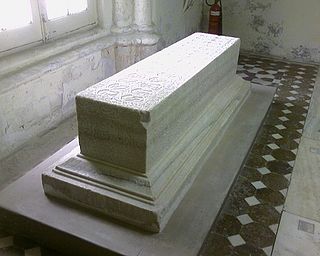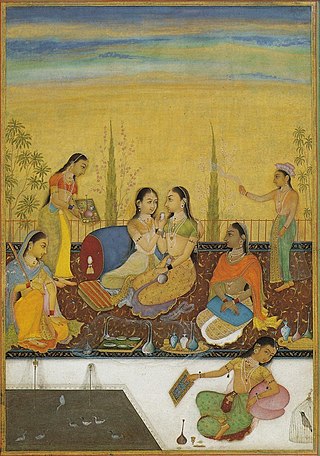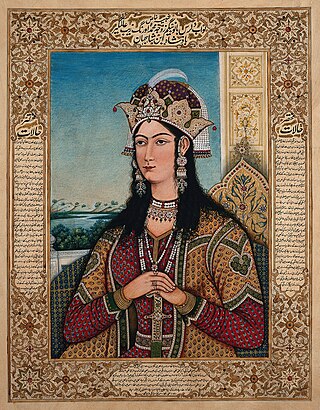Related Research Articles

Mirza Shahab-ud-Din Muhammad Khurram, also known as Shah Jahan I, was Emperor of Hindustan from 1628 until his deposition in 1658. As the fifth Mughal emperor, his reign marked the zenith of Mughal architectural and cultural achievements.

Jahanara Begum was a princess of the Mughal Empire. She was the second and the eldest surviving child of Mughal Emperor Shah Jahan and Mumtaz Mahal.

Dara Shikoh, also transliterated as Dara Shukoh, was the eldest son and heir-apparent of the Mughal emperor Shah Jahan. Dara was designated with the title Padshahzada-i-Buzurg Martaba and was favoured as a successor by his father and his elder sister, Princess Jahanara Begum. He had been given the title of 'Shah-e-Buland Iqbal' by Shah Jahan. In the war of succession which ensued after Shah Jahan's illness in 1657, Dara was defeated by his younger brother Prince Muhiuddin. He was executed in 1659 on Aurangzeb's orders in a bitter struggle for the imperial throne.

Mirza Abu'l Fayaz Qutb-ud-Din Mohammad Azam, commonly known as Azam Shah, was briefly the seventh Mughal emperor from 14 March to 20 June 1707. He was the third son of the sixth Mughal emperor Aurangzeb and his chief consort Dilras Banu Begum.

Mirza Shah Shuja was the second son of the Mughal Emperor Shah Jahan and Empress Mumtaz Mahal. He was the governor of Bengal and Odisha and had his capital at Dhaka, in present day Bangladesh.

Anarkali is a legendary lady said to be loved by the 16th-century Mughal Prince Salim, who later became Emperor Jahangir. According to some accounts, Anarkali was the nickname of the courtesan(tawaif) Sharf-un-Nisa, though scholars hold varying opinions.

Zenana is the part of a house belonging to a Muslim family in the Indian subcontinent, which is reserved for the women of the household. The zenana was a product of Indo-Islamic culture and was commonly found in aristocratic Muslim families. Due to prolonged interactions between Hindus and Muslims, upper-class Hindu households, inclined to imitate elite cultural trends, also embraced these designated spaces. The zenana were the inner rooms of a house where the women of the family lived and where men and strangers were not allowed to enter. The outer apartments for guests and men are called the mardana. Conceptually in those that practise purdah, it is the equivalent in the Indian subcontinent of the harem.

Mirza Muhammad Akbar was a Mughal prince and the fourth son of Emperor Aurangzeb and his chief consort Dilras Banu Begum. He went into exile in Safavid Persia after a failed rebellion against his father in the Deccan.

Dilras Banu Begum was the first wife and chief consort of Emperor Aurangzeb, the sixth Mughal emperor. She is also known by her posthumous title, Rabia-ud-Durrani. The Bibi Ka Maqbara in Aurangabad, which bears a striking resemblance to the Taj Mahal, was commissioned by her husband to act as her final resting place.

Manavati Bai, also spelled Manvati Bai,, better known by her title, Jagat Gosain, was the second wife and the empress consort of the fourth Mughal emperor Jahangir and the mother of his successor, Shah Jahan.

Mirza Sulaiman Shikoh was a Mughal prince and the eldest son of Crown prince Dara Shikoh. He was executed in May 1662 at Gwalior Fort on the orders of his paternal uncle, Emperor Aurangzeb.

Jahanzeb Banu Begum, popularly known as Jani Begum, was a Mughal princess and the chief consort of Muhammad Azam Shah, the heir-apparent to Emperor Aurangzeb, who briefly became Mughal emperor in 1707.

Rahmat-un-Nissa, better known by her title Nawab Bai, was a secondary wife of the Mughal emperor Aurangzeb. She gave birth to Aurangzeb's first two sons, including Bahadur Shah I, who became Mughal emperor in 1707. Nawab Bai was unpopular at the Mughal court and lost her husband's favour quite early on in her life while the misconduct of her sons, Muhammad Sultan and Muhammad Muazzam, embittered her latter life. She died in 1691 in Delhi after long years of separation from her husband and children.
Udaipuri Mahal was one of the concubines of the Mughal emperor Aurangzeb.
Aurangabadi Mahal was a consort (concubine) of the Mughal emperor Aurangzeb.

Padshah Begum was a superlative imperial title conferred upon the empress consort or 'First Lady' of the Mughal Empire and was considered to be the most important title in the Mughal harem or zenana. This title can be equivalent with "empress" in English, but in only approximate terms in the Mughal context.
Zainabadi Mahal was a concubine of Mughal emperor Aurangzeb.

The Mughal Harem was the harem of Mughal emperors of the Indian subcontinent. The term originated with the Near East, meaning a "forbidden place; sacrosanct, sanctum", and etymologically related to the Arabic حريم ḥarīm, "a sacred inviolable place; female members of the family" and حرام ḥarām, "forbidden; sacred". It has the same meaning as the Turkish word seraglio and the Persian word zenana. It is also similar to the Sanskrit word anthapura, meaning ‘the inner apartment’ of the household. It came to mean the sphere of women in what was usually a polygynous household and their segregated quarters which were forbidden to men.
During the Mughal Dynasty, urdubegis were the class of women assigned to protect the emperor and inhabitants of the zenana.
Nur-un-Nissa Begum was the first wife and chief consort of Mughal Emperor Bahadur Shah I.
References
- 1 2 Lal, K.S. (1988). The Mughal Harem. New Delhi: Aditya Prakashan. pp. 52–54. ISBN 8185179034.
- ↑ Manucci, Niccolao (1907–1908). Storia do Mogor. Vol. II. W. Irvine, tr. London: J. Murray. p. 331. OCLC 1420924.
- 1 2 Misra, Rekha (1967). Women in Mughal India. Delhi: Munshiram Manoharlal. p. 78. OCLC 473530.
- ↑ Hamiduddin Bahadur (1912). Ahkam-i-Alamgiri: Anecdotes of Aurangzib (translated into English with notes) and historical essays. Jadunath Sarker, tr. Calcutta: M. C. Sarkar. pp. 65, 71–72. OCLC 459363059.